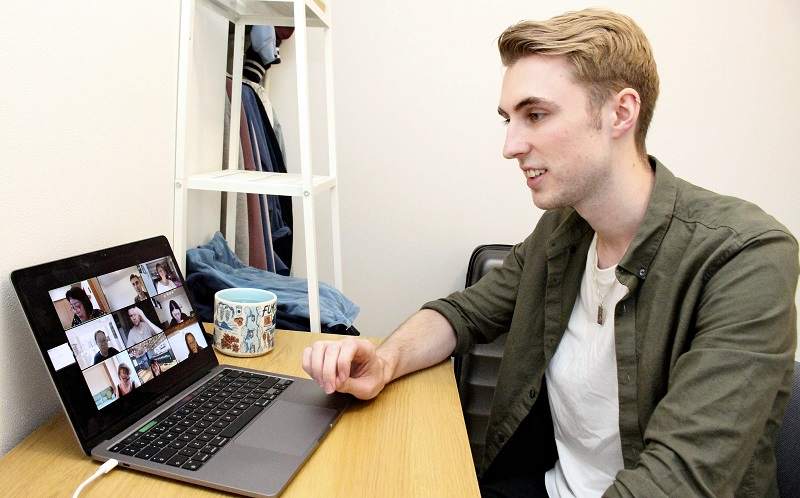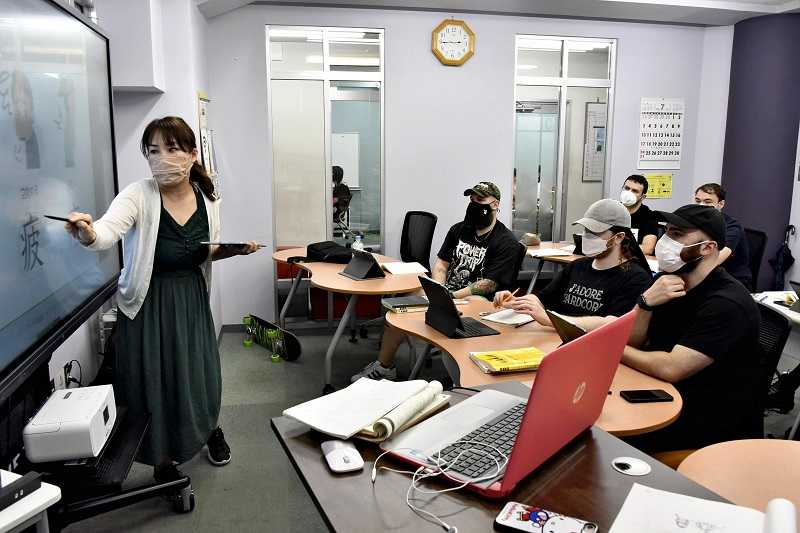Foreign students return / Overseas students finally start new chapter in life

Gregory McDonald remotely takes part in a Japanese-language class from his home in Shibuya Ward, Tokyo, on Aug. 4.
The Yomiuri Shimbun
6:00 JST, August 16, 2022
The recent relaxation of entry restrictions for foreigners opened the door back up for overseas students to learn in Japan. What awaits those who are finally here after a long delay? The Yomiuri Shimbun talked with students at Kai Japanese Language School, an institute in Shinjuku Ward, Tokyo, with students from 40 countries and territories. This is the first of a five-part series.
***
Briton Gregory McDonald landed at Tokyo’s Haneda Airport on March 23. Hearing Japanese spoken all around him was a thrill for the 23-year-old. Near the hotel where he spent the first night he could see rows of cherry trees about to burst in bloom.
It was the start of a new chapter in his life that he had eagerly awaited. He had finally made it.
When McDonald was a child, his father took a business trip to Japan as a management consultant. In the photos his father took, McDonald saw signs with kanji and hiragana characters, and he was intrigued when his father talked about the custom of bowing and other aspects of the country. It was a culture completely different from his own.
Someday I want to live there, he thought. McDonald’s chance to turn the dream into reality came after he graduated from university, when he decided to enroll at Kai Japanese Language School in Tokyo’s Shinjuku Ward. Classes were to start in June 2020.
But then the pandemic stepped in and disrupted his plans. Restrictions on entry into Japan forced him to put his trip on hold. When the restrictions were eased in October that year, he finally obtained a visa, paid the school fees and booked a Dec. 27 flight to Japan.
Then a variant of the coronavirus began spreading across Britain — on Dec. 23, the Japanese government announced a ban on all entries from Britain, starting the following day. McDonald could not get a ticket for a flight leaving on the night of Dec. 23.
The course started in January 2021. While 10 or so classmates were able to physically attend classes, he joined them remotely from Britain. Because of the time difference, the class ran from 4:40 a.m. to 8:30 a.m. British time, forcing him to wake up in the small hours of the night. This routine lasted for a year.
McDonald, whose Japanese-language ability had been limited to writing hiragana and katakana, improved to the point of being able to carry on an everyday conversation. But he felt envious of his classmates, believing he would have made more progress had he been in Japan.
It is now four months since he arrived in March. With Japan in the midst of a seventh wave of infections, his classes are sometimes conducted online. Aug. 4 was one of those days, and during the remote class, the theme of the discussion with classmates was what motivated them to study Japanese.
They pointed out each other’s grammatical errors and mistakes in word usage, which was not so different from the remote classes he took from Britain.
Still, he can try out words and expressions he has learned whenever he wants at restaurants and other places where he spends his days. To him, the time spent in class in Japan is irreplaceable for learning “real Japanese.”
Anxiously waiting
Currently, the school has about 190 students, but that number had dropped to 50 at one point due to the entry restrictions. The school set up an environment that enables students to attend classes from outside Japan, but some students have given up on ever coming to Japan.

Students from various countries sit in a class at Kai Japanese Language School in Shinjuku Ward, Tokyo, in July. The school is regaining its former bustle with the relaxing of entry restrictions on foreign students.
In November 2021, the school opened a chat room for overseas students waiting to come to Japan. Many students voiced confusion and anxiety, posting things like, “Will the chance ever come?” and “I can’t wait forever.”
Concetta De Sio, a 30-year-old Italian who started studying at the school in April, was one such person whose life was in limbo.
During a trip to Tokyo about five years ago, De Sio became fascinated with the fashion of people on the street and by the modern atmosphere. She quit her job as a fashion designer in February 2020 with a plan to come to Japan the following month.
However, the entry restrictions kept her from ever getting on a plane.
When the restrictions were eased in October that year, she applied for a visa, only to see the limits reinstated in December. During the two years it took to finally get to Japan, she made ends meet by working part-time jobs.
She said she would have taken as many PCR tests as she needed to get here, but that never was the issue. She was shut out, to the point where she felt like Japan was rejecting her.
De Sio finally entered Japan in late March and is taking the intermediate-level course at the school. She already plans to return to her job and will stay in Japan until the end of September.
With a goal of being able to speak fluently with Japanese people, she said she wants to improve as much as she can in the limited time she has left here.
Sharp decline
In 2008, the government set a goal, in line with its policy of internationalization, to increase the number of foreign students in Japan to 300,000 by 2020. According to the Japan Student Services Organization, the number reached a record 310,000 in 2019.
However, when the pandemic prompted stiff restrictions on the entry of foreigners in the spring of 2020, more and more students from abroad became unable to come to Japan.
According to the Immigration Services Agency, 510,000 non-Japanese entered or re-entered Japan on a student visa in 2019. That number plunged to 160,000 in 2020 and further to 30,000 in 2021.
The Certificate of Eligibility, which is required when applying for a student visa, was issued in 200,000 cases from 2020 to 2021, but as of Jan. 4 this year, 150,000 have not been used.
Fearing overseas students may abandon plans to come to Japan, a group of Japanese-language schools banded together in May 2021 to help open the door for students from abroad.
Hiroko Yamamoto, the director of Kai Japanese Language School, is among the leaders who spearheaded efforts by the Open the Borders to Safe Study in Japan Association.
The association provided a forum for frustrated prospective students, some of whom said they quit jobs only to find they were unable to enter Japan, or moved out of an apartment because they were heading to Japan. The association pressed the government to ease entry restrictions as soon as possible.
In March, the restrictions on students were relaxed. The government is now looking to reach the pre-pandemic goal of 310,000 foreign students annually by 2027.
Popular Articles
Popular articles in the past 24 hours
-

Diplomacy with Central Asia: Utilize Long-Established Relationshi...
-

Poll Finds High Approval Rating for PM Takaichi’s Economic Measur...
-

Japan Actor Ryoko Hirosue Given Summary Indictment over Car Accid...
-

Japanese Actors Haru, Mahiro Takasugi Announce Marriage
-

Japan Shares Rise as Bond Yields Retreat; Tech Jitters Weigh on N...
-

9 Japanese Police Officers Suspected of Online Casino Gambling
-

Hepburn Romaji Deemed Standard for Japanese Words, Names; Change ...
-

Hakone Ekiden Banners Hung at Tokyo's JR Shinagawa Station Ahead ...
Popular articles in the past week
-

Israeli Tourists Refused Accommodation at Hotel in Japan’s Nagano...
-

U.S. Senate Resolution Backs Japan, Condemns China's Pressure
-

Sharp Decline in Number of Chinese Tourists But Overall Number of...
-

Japan Set to Participate in EU's R&D Framework, Aims to Boost Coo...
-

China Attacks Japan at U.N. Security Council Meetings; Representa...
-

Japan Backs Public-Private Cooperation on Economic Security; Nati...
-

As Chinese Tourists Shun Japan, Hotels and Stores Suffer
-

Bus Bound for Hokkaido's New Chitose Airport Catches Fire Wednesd...
Popular articles in the past month
-

Tokyo Economic Security Forum to Hold Inaugural Meeting Amid Tens...
-

Keidanren Chairman Yoshinobu Tsutsui Visits Kashiwazaki-Kariwa Nu...
-

Imports of Rare Earths from China Facing Delays, May Be Caused by...
-

University of Tokyo Professor Discusses Japanese Economic Securit...
-

Japan Pulls out of Vietnam Nuclear Project, Complicating Hanoi's ...
-

Govt Aims to Expand NISA Program Lineup, Abolish Age Restriction
-

Blanket Eel Trade Restrictions Rejected
-

Key Japan Labor Group to Seek Pay Scale Hike
"Society" POPULAR ARTICLE
-

M4.9 Earthquake Hits Tokyo, Neighboring Prefectures
-

Israeli Tourists Refused Accommodation at Hotel in Japan’s Nagano Pref., Prompting Protest by Israeli Embassy and Probe by Prefecture
-

M7.5 Earthquake Hits Northern Japan; Tsunami Waves Observed in Hokkaido, Aomori and Iwate Prefectures
-

Tsukiji Market Urges Tourists to Avoid Visiting in Year-End
-

High School in Kyoto Says Students Shoplifted during Recent School Trip to Bali, Indonesia
JN ACCESS RANKING
-

Tokyo Economic Security Forum to Hold Inaugural Meeting Amid Tense Global Environment
-

Keidanren Chairman Yoshinobu Tsutsui Visits Kashiwazaki-Kariwa Nuclear Power Plant; Inspects New Emergency Safety System
-

Imports of Rare Earths from China Facing Delays, May Be Caused by Deterioration of Japan-China Relations
-

University of Tokyo Professor Discusses Japanese Economic Security in Interview Ahead of Forum
-

Japan Pulls out of Vietnam Nuclear Project, Complicating Hanoi’s Power Plans








